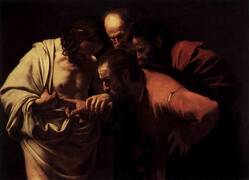Saint Thomas, the twin
One of Jesus's twelve apostles (along with Peter, Andrew, James & John, Philip, James, Matthew, Bartholomew, Simon & Jude, & Judas Iscariot)
Born in 1st century AD in Galilee
Martyred on 3 July 72 in Parangimalai, Chennai, Chola Empire (present day St Thomas Mount, Tamil Nadu, India)
Feast Day - 3rd July
Major shrines: St Thomas Cathedral in Chennai; Basilica of St Thomas in Ortona, Italy
Patron saint of India & Sri Lanka
Catechesis by Papa Benedict XVI 
General Audience, Wednesday 27 September 2006 - also in Croatian, French, German, Italian, Portuguese & Spanish
"Dear Brothers and Sisters,
Continuing our encounters with the Twelve Apostles chosen directly by Jesus, today we will give our attention to Thomas. Always present in the four lists compiled by the New Testament, in the first three Gospels he is placed next to Matthew (cf Mt 10, 3; Mk 3, 18; Lk 6, 15), whereas in Acts he is found next to Philip (cf Acts 1, 13). His name derives from a Hebrew root, ta'am, which means "paired, twin". In fact, the Gospel of John several times calls him by the nickname "Didymus" (cf Jn 11, 16; 20, 24; 21, 2), which in Greek precisely means "twin". The reason for this name is not clear.
Above all the fourth Gospel offers us information that outlines some significant features of his personality. The first concerns his exhortation, which he makes to the other Apostles, when Jesus, at a critical moment of his life, decides to go to Bethany to raise Lazarus, thus coming dangerously close to Jerusalem (Mk 10, 32). On this occasion Thomas said to his fellow disciples: "Let us also go and die with him" (Jn 11, 16). This determination of his to follow the Master is truly exemplary and offers us a precious teaching: it reveals total willingness to adhere to Jesus, all the way to identifying his own fate with that of Jesus and to wanting to share with Him the supreme trial of death. In fact, the most important thing is never to distance oneself from Jesus. Moreover, when the Gospels use the verb "to follow", it means that where He walks, there his disciple must also go. In this way, Christian life is defined as a life with Jesus Christ, a life to spend together with Him. St Paul writes something analogous, when he assures the Christians of Corinth: "You are in our hearts, to die together and to live together" (II Cor 7, 3). What takes place between the Apostle and his Christians must, obviously, be valid first of all in the relationship between Christians and Jesus himself: dying together, living together, being in his heart as He is in ours.
A second intervention by Thomas is recorded at the Last Supper. On this occasion Jesus, predicting his own imminent departure, announces that he was going to prepare a place for his disciples so that they could also go where he will be; and he explains to them: "The place where I am going, you know the way" (Jn 14, 4). It is then that Thomas intervenes, saying: "Lord, we do not know where you are going, so how can we know the way?" (Jn 14, 5). In reality, with this comment he places himself at a rather low level of understanding; but these his words provide Jesus with the opportunity to pronounce the famous definition: "I am the Way, the Truth and the Life" (Jn 14, 6). Thus, it is primarily to Thomas that he makes this revelation, but it is valid for all of us and for all time. Every time we hear or read these words, we can in thought stand next to Thomas and imagine that the Lord is also speaking with us just as he spoke with him. At the same time, his question also confers upon us the right, so to speak, to ask Jesus for explanations. We often do not understand him. Let us have the courage to say: I do not understand you, Lord, listen to me, help me to understand". In such a way, with this frankness which is the true way of praying, of speaking with Jesus, we express the paucity of our capacity to understand, and at the same time we place ourselves in the trusting attitude of one who expects light and strength from the one able to provide them.
Then there is the well-known and proverbial scene of the doubting Thomas, that occurred eight days after Easter. Initially, he had not believed that Jesus had appeared in his absence, and had said: "Unless I see in his hands the print of the nails and place my finger in the mark of the nails, and place my hand in his side, I will not believe" (Jn 20, 25). At base, from these words emerges the conviction that Jesus is henceforth recognized not so much by his face as by his wounds. Thomas considers that the marks that confirm Jesus' identity are now above all his wounds, in which he reveals to what end He has loved us. In this the Apostle is not mistaken. As we know, eight days later Jesus reappeared among his disciples, and this time Thomas was present. And Jesus summons him: "Put your finger here and see my hands; stretch out your hand and place it in my side; and no longer be incredulous, but believe" (Jn 20, 27). Thomas reacts with the most splendid profession of faith in the whole of the New Testament: "My Lord and my God!" (Jn 20, 28). In this regard, St Augustine comments: Thomas "saw and touched the man, but confessed his faith in God, whom he neither saw nor touched. But what he saw and touched led him to believe in what until then he had doubted" (In Johann 121, 5). The Evangelist continues with Jesus' last words to Thomas: "Because you have seen me, you have believed: blessed are those who have not seen and yet believe" (Jn 20, 29). This phrase can also be put in the present tense: "Blessed are those who do not see and yet believe". In any case, Jesus here enunciates a fundamental principle for Christians who will come after Thomas, thus for all of us. It is interesting to note how another Thomas, the great Medieval theologian of Aquinas, juxtaposed this formula of blessedness with the apparently opposite one recorded by Luke: "Blessed are the eyes which see what you see!" (Lk 10, 23). But, Aquinas comments: "Those who believe without seeing are much more deserving than those who believe by seeing" (In Johann. XX lectio VI 2566). In fact, the Letter to the Hebrews, recalling the whole series of the ancient biblical Patriarchs, who believed in God without seeing the fulfilment of his promises, defines faith as "the assurance of things hoped for, the conviction of things not seen" (Heb 11, 1). The case of the Apostle Thomas is important for us for at least three reasons: first, because it comforts us in our insecurities; second, because it shows us that every doubt can lead to an outcome brighter than any uncertainty; and, lastly, because the words addressed to him by Jesus remind us of the true meaning of mature faith and encourage us to carry on, despite the difficulties, along our pathway of adherence to Him.
A final note on Thomas is preserved for us in the fourth Gospel, which presents him as a witness of the Risen One in the subsequent event of the miraculous catch on Lake Tiberias (cf Jn 21, 2). On that occasion, he is even mentioned immediately after Simon Peter: an evident sign of the considerable importance that he enjoyed within the first Christian communities. In fact, in his name were written the Acts and the Gospel of Thomas, both apocryphal works but nonetheless important for the study of Christian origins. Finally let us remember that, according to ancient tradition, Thomas evangelized first Syria and Persia (refered to thus by Origen, reported by Eusebius of Caesarea, Ecclesiastical History 3, 1) then he went on to Western India (cf Acts of Thomas 1-2 & 17ff), from where finally he also reached Southern India. Let us end our reflection on this missionary perspective, expressing the hope that the example of Thomas will confirm more and more our faith in Jesus Christ, Our Lord and Our God."


